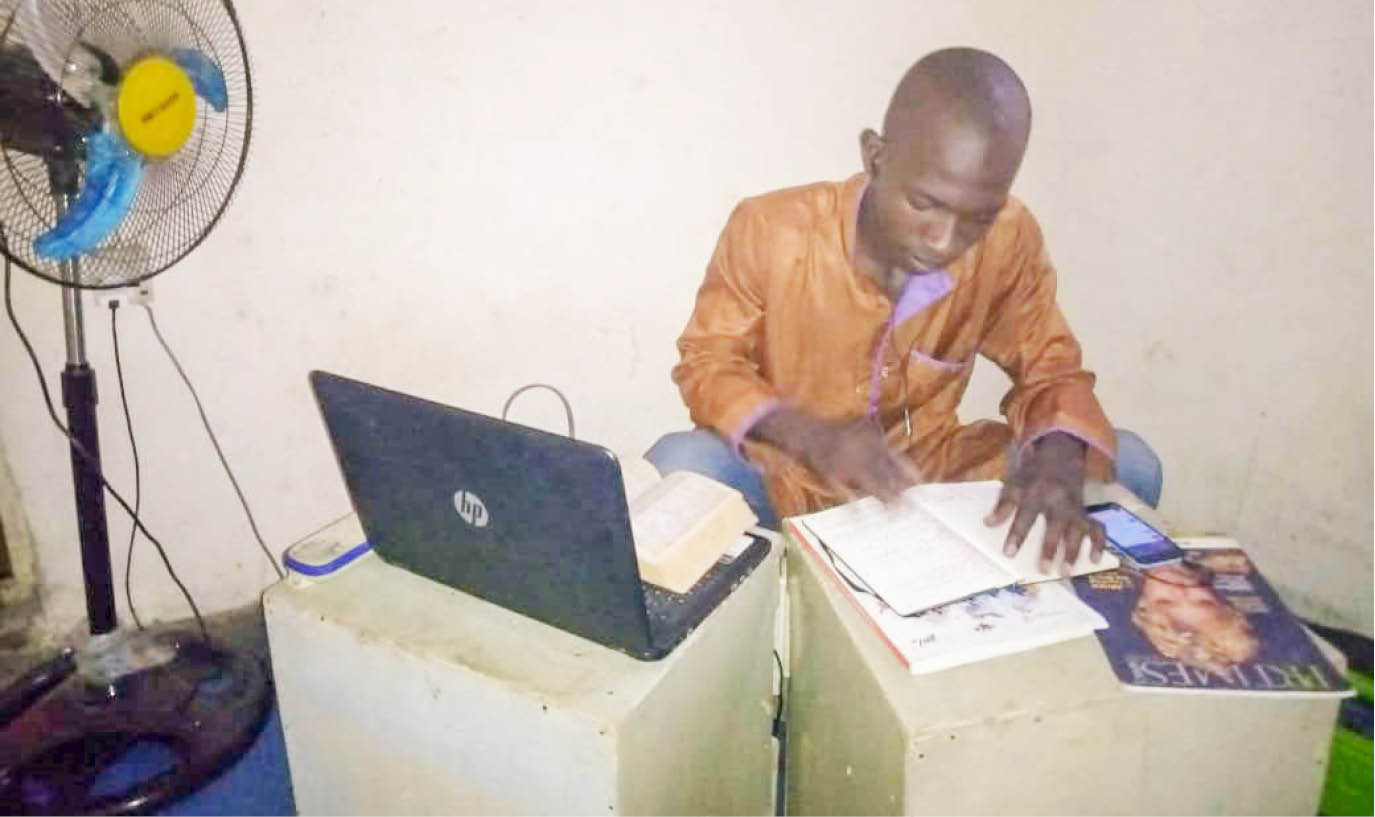All the gaps in the plan had been stopped. The activities required had been mapped. What each would need was costed. Each actor was known and in place. The plan was ready lock, stock and barrel.
Lilian Okafor lined it up and tapped a button that said “enter”. That launched the country’s latest plan to deal with the coronavirus pandemic.
The bytes of information snowballed into kilobytes and megabytes, outlining the shape of how Nigeria planned to deal with the nutrition fallout from Covid-19.
They poured across network stations, into mobile and desktop devices of more than 110 journalists. Then emerged a blitzkrieg of stories that spotlighted hunger, malnutrition, famine—and how the pandemic could make everything worse.
The pandemic was raging. It was a war being fought in every inch of available space.
Okafor found her space even without leaving her home. She hasn’t left that spot since late March when the pandemic forced a lockdown upon the country. “Covid-19 has had significant impact on my work space,” she says.
In early April, Nigeria was already sucked in by the coronavirus pandemic raging across the world. Dozens of new infections were trickling in daily to light up the dashboard that kept score on cases of Covid-19.
All the signs of an imminent lockdown loomed. The World Health Organisation was already warning of—and advising on—it.
National governments were flexing to begin one, and employers were being advised what steps they could take to protect employees. The mantra was to ‘shelter in place’, ‘stay home’, ‘work from home’, ‘keep social distance’.
Turning point for corporate flexibility
The pandemic hit employers and employees with a new shock: that many workers could actually work from home, an idea that seemed previously unheard-of.
Businesses scaled down work and human resources units peered through job descriptions to determine who could work from home and who had to be physically present. The lines emerged between “essential” and “non-essential”, but it also spotlighted the divide between virtual and on-site work.
“Everything has gone virtual,” says Sharon Grey, a public relations and communications advisor. She is based in Lagos, one of three locations to first go into lockdown on March 30. Her firm had ordered employees to work from home even before then.
“I’ve been working from home since the whole thing started, I haven’t been to the office at all. The guys going to work are those that need to be physically there. Like accountants, maybe for files and things, some admin guys and HR.
“So if anyone wants to be at the office, they have to take permission. The reason is because management is trying to reduce the number of people in the office at the same time. And this is so there’s enough space between everyone at certain times.”

A new version of the head office
Two metres apart was the spacing required to ensure physical distancing, according to the Nigeria Centre for Disease Control.
The centre also issued a raft of advisories for businesses going into lockdown. With eased lifting of the lockdown, the advisories are being finetuned to targeted sectors.
The NCDC has published a guideline for employers and businesses in Nigeria, it said.
However, “the agency is working with various industries to develop sector-specific guidelines as the financial sector and manufacturing industry is fully open while the informal sector will have a phased opening.”
The new version of the office is one that’s limiting contact and putting in enough space and barriers to look like a hospital.
Even before arrival at work, a face mask in public is a must that public-health authorities are serious about. While states made masks mandatory, others opened mobile courts and imposed fines for not wearing one.
Some firms have taken the seriousness notches higher. Businesses insist on visitors masking before entry. Employees are required to have a mask on before arrival and all throughout stay within work premises. Workers have been sanctioned—as much as suspended—for not having one on.
Handwashing stations are the first contact, followed by a mandatory temperature check. Time-and-attendance systems that use biometrics like fingerprint are out; the good old pen-and-paper attendance register is back.
Lunch gardens and water cooler moments are out. Talking behind a face mask from 2m across is in. The number of people present is reduced. And HR takes steps to limit the probability of touching surfaces: elevators are powered down so you don’t touch floor buttons, stairs are the new workplace aerobics, rails are routinely wiped down, doors are permanently ajar.

Work changing homes
While work spaces are under pressure to become coronavirus proof, homes are struggling to be work ready.
Okafor chose her space early on as the lockdown became inevitable. A communications officer at a nongovernment organisation, her job involved lots of travel, meetings, field visits, conferences, workshops—all of it in person. At any one time, each had dozens of people packed around tables in halls in any state across the country.
“All of that has changed, all of it has stopped. Any working from office was halted,” she recalls of the start of the work-from-home directive. “I had to convert some space in my house to an office, like a work-ready home setting.”
The work station is a chair for sitting, a desk to hold a laptop—and all the bits and bobs that come with that—and, very importantly rigged for internet connection.
It is a near replica of her in-person office space, except for the blare of the living-room television, the on-the-clock break to make her family’s meals and her little toddler bounding about the house and tugging on the leg of her desk.
With workforces around the world already gone virtual, staying connected online is as important as the volume of gigabytes that’s spent on it. Online conferencing apps and platforms—from Zoom and Hangout to Skype and Join.me—have replaced office meeting desks and chairs, and businesses are falling over themselves to secure just the best suited for virtual work.
While setting up her work-ready home, Okafor mapped “Zoom-ready spots for video conferencing and online meetings” as well. She goes through sessions of Zoom meeting every day for hours, some as a participant, some as a host. She has to appear professional in each meeting, even while seated in her bedroom or the “work-ready” corner of her home. They come with their own demands for etiquette and professionalism. They also come with their cost-and-benefit ratio.
A typical one-on-one Zoom session using basic-grade HD video consumes around 540MB/hr. Higher-grade video meetings going up to 720p will wipe 1.08GB off your data plan every hour.
Few Zoom meetings last under half an hour. Unpredictable but expected fits and starts can stretch a scheduled 30-minute meeting anywhere between 45 minutes and one hour.
A look at data bundle costs helps do the calculus: working from home doesn’t come cheap. Online meetings can wipe out a month’s worth of data bundle in just under five days. They lend themselves to some products like a charm—like the digital marketing Musa Ahmad oversees, seated in his Lagos home and visible in any corner of the world over the internet.
A sports journalist, storyteller, tourism practitioner, and design-and-planning expert rolled into one, his work was 360-degrees—100%–prepared to switch to working remotely even before Covid-19. Such a move considered time frames to deliver projects, distractions, productivity, and possible earnings.
“The product is there and how much I earn has increased, but not much,” says Ahmad. “I have to spend on data and petrol to stay online. And there are the cables permanently plugged in 24 hours to electricity. They pack, and I have to keep replacing them. I am burning data attending Zoom meetings. It is really expensive. Consider the poor network all over, not just here. We have had to reschedule a lot of meetings with clients even in Singapore, despite their fast connectivity.”
There have been complaints of a new-fangled phenomenon known as Zoom fatigue. There is also the general disruption that an online environment lends itself to. What’s to stop the mouse hovering over a link and launching an interesting webpage while you are gathering data on games is a challenge Ahmad has seen.
“This tech stuff is very distractive. You have to be centred while online. It affects your mentality and energy,” he says.

A barrage of new acronyms
In pre-Covid-19 days, Ahmad enjoyed the office experience and its solidity while working. “When I have shortcomings and questions, I got to ask colleagues and partners and attend to them in the immediate, and we work together as a team,” he says. That shifted since going remote. He still gets to ask questions and listen to possible ways out of tangles, but talking to colleagues virtually has taken something away. “The energy is not the same,” he says.
Learning is at the heart of the virtual-ness that the pandemic has thrust upon the world. And Ahmad’s business is to package the best product, experience and realism for clients. “I want to be different from colleagues in my industry. I like to extract the best my audience will like,” he says. “Customers need to feel the realism of everything they are using.” From the meticulousness of an in-person interview with a sports pro to the realism of a tour package, all of that stopped since March—and are only starting to return.
Businesses are turning to the learning—the e-learning—that’s now front and centre. Teachers and students left the classroom since March. UNESCO estimates 60% of the world’s student population were put out of learning spaces as schools closed from country to country.
But from Edo to Lagos state, teachers are entering the homes of their students with tutorials and lessons packaged as WhatsApp videos and a plethora of emerging e-learning solutions.
Hadiza Ibrahim, studying for an MA in journalism and public relations at Griffith College, Dublin was put out of school. Her school library went virtual, affording her access to all the books she needed for her research. She needed key informant interviews for her thesis, she scheduled meetings on Zoom.
When her child stopped school in March, Helen John followed him home. She stopped attending her fashion-design classes in person and tracked down tutors who could offer online trainings. She boasts better surfing skills online, switching between videos teaching how to hem the perfect seam and another claim about coronavirus
Okafor had to invest in data enough to “improve it drastically to be able to alight with current realities,” she says of her rising investment in what she need to stay online. “My ICT skills, my IT skills have improved greatly. I have upskilled my ICT knowledge to be able to work and seized a lot of opportunities for training.”
Retiring is the new attire
Times have changed from the days of business suits, corporate ties and leather shoes polished to within an inch of their life. So, too, for the skirt suit and high heels that go with the work space.
Different business sectors are approaching the new dress mode differently. And it is being mostly determined by who is on the other end of the video conference.
Some have joined video meetings while walking on the street, others lounging in bed, but still more sitting at a desk. What’s changed most is the wear.
No more dressing for work, but dressing for convenience. “My work attire is now retiring,” says Okafor. “I’m getting more comfortable with dressing more comfortable.”
“I rarely dress up for work these days. Before Covid-19, a lot tended toward official attire and wear. My trend toward casual wear now is greatly improved. You don’t have to bother about making your hair, dressing up, wearing heels.” It seems a contradiction, but career analysts predict it rolling out across the corporate world.
“Maybe some people in Finance will keep the button-down and tie or the blouse and pearls, but the trend toward casual attire will accelerate quickly,” writes William Arruda, cofounder of CareerBlast and author of Digital YOU: Real Personal Branding in the Virtual Age.
In an article for Forbes, he says, “Already, some consulting firms and other organizations have ‘dress for your day’ policies where if you’re not meeting with clients, you can leave the suit at home. Besides, people working in tech have been wearing shorts and flip flops to work for decades.”

Virtuoso commando
As video conference apps increasingly integrate into the work space, so are businesses considering whether their investment are in the right places.
Odoh Okenyodo, founder of a development communications firm in Abuja, saw the disruptions like the ones from coronavirus coming—and has seen savvy investors reduce investment in brick-and-mortar infrastructure and increase focus on virtual work.
That way, he says, work continued nonstop even as the pandemic continued to rage. “I’d say we have been 100% ready.”
Working from home helped business reduce the number of people physically present on-site.
“It also showed up redundancies, when you have jobs being done by 100 people before Covid-19, now being done by 20 people,” says IT expert Mike Tersoo.
The result isn’t just pay cuts but the exposure of many workers seemingly “doing nothing” and eventual layoffs, he says.
In his assessment, the “work from home” experience has forced businesses to evaluate their ICT compliance—and opened up lots of gaps in industries supposedly led by IT, like the media.
Online publications didn’t feel much different; they have their content management app.
But print publications suffered pagination cuts. Many that used priority workflow software switched to plain emails.
They are also looking toward multi-module programmes that can take the tasks of human resources, accounts, finance, store and even production online.
“Nearly everything can be done online in this industry. All you need is to have internet connectivity,” says IT analyst Martin Hassan. “Even servers can be monitored online. The only problem is power outages that cause disruptions when you are not onsite.”
Bleeding lines between spaces
Individuals have to consider how work life, forced outside the work space, is intertwining with personal life.
Before Covid-19, Okafor considered her two-year in the morning before work, then he was in crèche till evening.
That separation is fast eroding between him interruptions Zoom meetings and demanding lunch while she worked between video calls. It isn’t just family.
“Colleagues send tons of WhatsApp messages even at unofficial hours and you have to attend to all those,” she says.
“Work life is gradually starting to mingle with personal life, it is somehow difficult to separate. Colleagues you haven’t had opportunity to visit, you get to see their environment. Work life is revealing one’s personal life these days. Personal activities are intruding into work life thanks to Covid-19.”
It’s a strange, new world.
Find a Spark presentation below


 Join Daily Trust WhatsApp Community For Quick Access To News and Happenings Around You.
Join Daily Trust WhatsApp Community For Quick Access To News and Happenings Around You.


